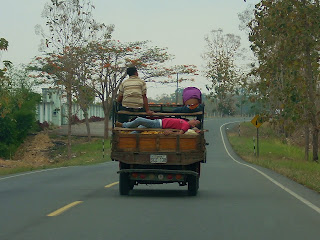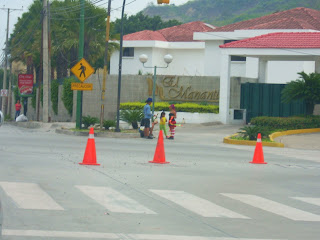After spending a month in Tennessee, I’m heading back to Guayaquil - just for a week this time. Waiting for the plane to board, I thought I’d look through my photos to reminisce, try to prepare myself for the big city, and find something I can post to my blog quickly. I have so many untold stories about our year in Guayaquil... and thousands of photos. Yikes! I get lost in la la land when I start looking at them.
I came across this photo, which is actually one of my favorites because it has a double meaning for Mike and me. This sign is posted in the entrance hallway of the MegaMaxi grocery store near our apartment. MegaMaxi is the most modern and highest quality grocery store in Ecuador. It’s like a small WalMart; you can buy clothes and tires in addition to groceries. I love this No Dogs sign because I think it exemplifies the coping strategies and personalities of the Ecuadoran people:
Make-do: This was the only clip art of a dog that was available.
Resourcefulness: Somebody had a dog show (the prohibited symbol was added later), they saved the signs, and they were a friend of somebody who knew somebody who needed a dog sign.
The survival/take care of yourself first kind of attitude: Perhaps the person who was selecting the dog thought, “Hey, this is a good one. I like dachshunds.” Or “Hey, this is a good one. I got bit by a weiner dog once. I hate those dogs.”
Impulsiveness (I really want to call this one the lack of practice in critical thinking skills explanation.): Need a dog symbol. Google dog. First dog that pops up. There’s a dog! Done! No thought at all about generalization or the best representation for dog.
Fear factor: O.k., in Ecuador it could really mean no male dachshunds. Perhaps one of the rich customers brings her dachshund shopping with her, and it pees on the display cases. The store employees would be afraid to tell the customer in person not to bring in the dog.
So I’ve wondered for a year which one it was.
The other meaning is a more personal one - kind of a joke between Mike and me. We don’t have any dogs. Mike doesn’t like dogs in the house. He doesn’t like dogs on the couch. My mom has a dog, a dachshund, and when she comes to visit, she brings the dog. It’s a house dog, not an outside dog, and not the kind of dog that just lays on the floor. I wouldn’t be surprised if Mike posts a similar sign on our front door the next time my mom comes to visit.

















































